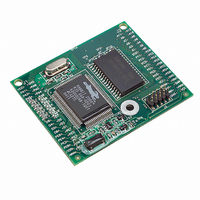20-101-0383 Rabbit Semiconductor, 20-101-0383 Datasheet - Page 19

20-101-0383
Manufacturer Part Number
20-101-0383
Description
MODULE RABBITCORE RCM2020
Manufacturer
Rabbit Semiconductor
Datasheet
1.20-101-0383.pdf
(80 pages)
Specifications of 20-101-0383
Module/board Type
MPU Core Module
Product
Microcontroller Modules
Core Processor
Rabbit 2000
Clock Speed
18.432 MHz
Interface Type
Ethernet, Serial
Flash
256 KB
Timers
5 x 8 bit, 2 x 10 bit
Operating Supply Voltage
4.75 V to 5.25 V
Board Size
48.3 mm x 58.4 mm x 14 mm
Core
RCM2020
Processor Series
RCM2000
For Use With/related Products
RCM2020
Lead Free Status / RoHS Status
Lead free / RoHS Compliant
Other names
316-1082
• Setting break points. The
• Watch expressions. A watch expression is a C expression that is evaluated on command
3.1.1.7 Cooperative Multitasking
Cooperative multitasking is a convenient way to perform several different tasks at the
same time. An example would be to step a machine through a sequence of steps and at the
same time independently carry on a dialog with the operator via a human interface. Coop-
erative multitasking differs from another approach called preemptive multitasking.
Dynamic C supports both types of multitasking. In cooperative multitasking each separate
task voluntarily surrenders its compute time when it does not need to perform any more
activity immediately. In preemptive multitasking control is forcibly removed from the task
via an interrupt.
Dynamic C has language extensions to support multitasking. The major C constructs are
called costatements, cofunctions, and slicing. These are described more completely in the
Dynamic C User’s Manual. The example below, sample program
costatements. A costatement is a way to perform a sequence of operations that involve
pauses or waits for some external event to take place. A complete description of costate-
ments is in the Dynamic C User’s Manual. The
independent tasks. The first task flashes LED DS2 2.5 times a second. The second task
flashes DS3 every 1.5 seconds.
User’s Manual
the cursor position if the program has already been compiled. You can set a break point
if the program is paused at a break point. You can also set a break point in a program
that is running at full speed. This will cause the program to break if the execution
thread hits your break point.
in the watch window. An expression is basically any type of C formula that can include
operators, variables and function calls, but not statements that require multiple lines
such as for or switch. You can have a list of watch expressions in the watch window. If
you are single-stepping, then they are all evaluated on each step. You can also com-
mand the watch expression to be evaluated by using the
watch expression is evaluated at a break point, it is evaluated as if the statement was at
the beginning of the function where you are single-stepping. If your program is running
you can also evaluate watch expressions with a
runwatch()
involving global variables can be evaluated, and the expression is evaluated as if it
were in a separate function with no local variables.
command that is frequently executed. In this case, only expressions
F2
key is used to turn on or turn off (toggle) a break point at
FLASHLEDS2.C
<Ctrl-U>
<Ctrl-U>
if your program has a
sample program has two
FLASHLEDS2.C
command. When a
, uses
15

















